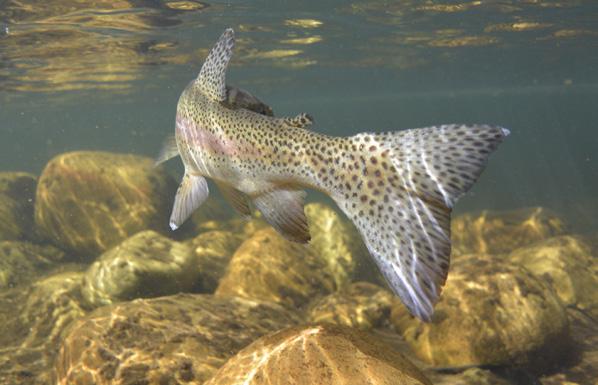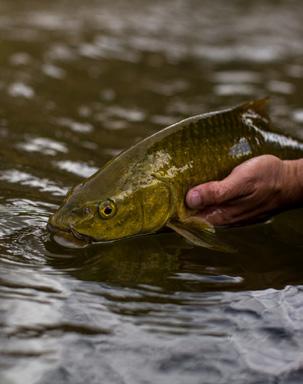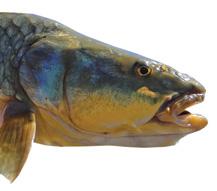
10 minute read
Pay Day
DEEP WANTS PAY DAY
HELLACIOUS SECOND-HAND ORGANS FOR A SNAZZY PIMPED SKIFF AND A BOOK FOR BELMAN AND CORBINA
THE SKIFF – HELLSBAY X ORVIS
If there was a market for well used spare kidneys, we would have flooded it by now to make a down payment on this special edition skiff collaboration between Hell’s Bay Boatworks and Orvis. Basically, you pick the flats skiff you want/need and upgrade to the Orvis package, which includes unique colour accents, upgraded components (full carbon decks and SeaDek traction) and an Orvis bounty (a Helios 3 rod, Mirage reel and boat bag). $500 of every purchase goes towards conservation partners like the Bonefish and Tarpon Trust or Captains for Clean Water. Now, how important is the pancreas and will it cover international shipping? hellsbayboatworks.com

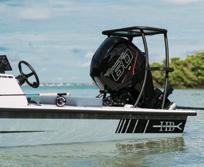


THE BOOK – THE CORBINA DIARIES
“Many fishermen think of corbina as the Howard Hughes of the surf. They are often talked about but relatively few are seen…” When we read this line from the intro to The Corbina Diaries, we could not help make the connection with belman (a close cousin of the corbina). Even since we heard that local legend Jannie Visser managed to catch a belman on fly we have been obsessing even more than usual over this tasslemouthed target from the South African coast. We wager the similarities between these fish are not limited to looks. From techniques and tactics to fly patterns, in The Corbina Diaries, species pioneer Quattrocchi has put together the ultimate granular guide for these spooky denizens of the Californian coast. Whether you manage to get a corbina or bellman on fly or not, Quattrocchi’s hard-earned knowledge can only make you a better surf fly angler. love2flyfishmedia.bigcartel.com

A LEERVIS BY ANY OTHER NAME…
A LEERIE IS A LEERIE IS A LEERIE, RIGHT? WRONG. TURNS OUT THERE ARE PROBABLY FOUR LEERIE TYPES AND THEY HAVE ALL BEEN SHARING THE SAME SCIENTIFIC NAME FOR WAY TOO LONG.
By Tudor Caradoc-Davies Photos. Fred Davis, Peter Coetzee, Knut Otto, Eduard Berruezo & Carles Berruezo
Like most people, from time to time I fall down a Google rabbit hole.
Does a platypus have nipples?
What is Duduzane Zuma’s address in Dubai?
What WAS that leaking off Rudy Giuliani’s head?
While all of those subjects and their answers (no nipples; the 18th floor of the Burj Khalifa in Dubai; and liquefied baby seals) are all fascinating, sometimes it’s a case of ask and ye shall not find. Sometimes a computer says “no”. The non-answer that’s been bothering me for a while is the Latin name for leervis, Lichia amia. The problem is that there is just one Latin name when there appear to be several species of ‘leervis’, ‘leerfish’ or ‘garrick’ swimming around. Take a search deep dive into the taxonomic background of leervis yourself. What comes back is just Lichia amia. That’s it.
Now, I know first-hand that there is a kind of leervis caught off Gabon that looks different to the one we get down here in South Africa. It’s boxy in shape and spotty. There’s also another one that you find in the Mediterranean that looks more like our one but is even bigger. And then, of course, there’s our local leerie, the Crease Fly-smashing, queenfish-like predator of our oceans and estuaries. At a glance it looks pretty similar to the Med version. I dug around old posts on online fishing forums where I made a little progress, but not enough. Seasoned anglers speculated that there were four distinct leervis – the Mediterranean, the Tropical West African (also found in Northern Angola), the Southern Angolan and the South African. To get some scientific clarity, I mailed Prof. Warren Potts, Associate Professor in the Department of Ichthyology and Fisheries Science at Rhodes University. He roped in his ichthyology colleagues Dr Alex Winkler and Dr Ed Butler, who both work from or with Rhodes University. Our back and forth revealed a few surprises:
SAME SAME BUT DIFFERENT
So, are all Lichia amia alike or are there different species? Potts had this to say, “There are three populations of warm temperate leervis that are found in South Africa, Namibia and in the Mediterranean. We compared the genetics of the South African and Angolan population and found deep genetic divergence (they are probably separate species). Based on the large differences that we found between the Angolan and South African populations, we also expect the Med fish to be different.” Ed weighed in with, “I have never experienced the Mediterranean species in the flesh, but have encountered the other three. The species in South Africa and southern Angola pretty much look the same and the Med species fits in here too. The three populations look more or less the same, but may have a number of biological, genetic or other differences and may well be separate species. However, the tropical variant encountered in northern Angola/ Gabon etc. is very different… well, at least in appearance. It has a much deeper body in relation to its length (almost like a West coast steenbras does in comparison with our white steenbras, for example). They also have beautiful markings/dots along their flanks, which our leerie don’t really have. The first time I saw one whilst working from the Kwanza River in Angola, we knew immediately that it was something different and I actually ended up stuffing it into a suitcase in between all my clothes and flying it back to South Africa a few days later.” Potts says, “In terms of the biology of the tropical leerfish from West Africa, we are really not too sure. For now, we assume that it is similar to the warm temperate species, with spawning at sea, recruitment into estuaries and increasing use of the coastal ocean as they mature. We have no idea of their size at maturity or how fast they grow, but their feeding is probably similar (primarily piscivorous).”


Conrad Botes with a tropical leervis caught in Gabon. Thought to be the original leervis described by Linnaeus, it’s likely to retain the Lichia amia name.
THE ORIGINAL LEERVIS
The funny thing is that it turns out the ‘rare’, ‘new’ (to me), ‘tropical’ leervis that set me off on this taxonomic goose chase is probably the original Lichia amia. The rest of the gang with the shape, colour and lateral lines we know so well, are likely to be the variants. Potts explains, “The original description of Leerfish (then called Scomber amia) was by Linnaeus in 1758. This was based on a description of a specimen captured in West Africa and is the tropical leerfish. This specimen does not look like the warm temperate leerfish, but someone, at some stage, obviously felt that they were the same species and hence the South African, Angolan and Mediterranean Leerfish have always been called Lichia amia. So, at the moment, we have a taxonomic mess.
THE SCIENTISTS NEED YOUR HELP
Check your tackle, pack your bags and gird your loins dear reader, for once you finally have a real excuse to go fishing. Science needs you! Ed says, “An entire revision of the species complex is needed. To add to the taxonomic mess, the ‘type specimen’ or individual on which Linnaeus’s original description of the species was made all those years ago, has been lost somewhere in Europe (I think). These ‘type specimens’ are pretty important to taxonomists and are essentially their benchmark from which new comparisons can be drawn. A new ‘type specimen’ needs to be declared first, from the original location where the species was first described. After that, a number of specimens from each population need to be compared in order to tease apart the story.” Potts says, “The problem is that for a robust taxonomic division of two species, scientists normally rely on genetic and morphological comparisons of a large number of specimens (of different sizes). This means that we have to collect and kill a large number (min 30) from each area. That is something that is not only expensive (especially the transport of large fish and the collection of all sizes), but something we also do not want to do as we don’t want to unnecessarily kill these amazing fish. We are thinking about using existing photos (of fish lying flat, with some observable size reference) and computer technology to look at morphology, but that would take some time to get enough suitable photos.”

Brothers Eduard Berruezo and Carles Berruezo group hug a Mediterranean leervis.
As an angler, Potts says you can help decipher the taxonomic leerie puzzle in the following ways:
1) Sort out the warm temperate leerfish conundrum
“We have genetic samples of the warm temperate leerfish from SA and Angola and we can collect specimens and photos here without too much difficulty. We do need genetic samples and whole specimens from the Med and need anglers to do this collection for us. Winkler has begun this process in the Med but needs assistance. “I have contacted scientists in Spain who have agreed to be on the lookout for Mediterranean leervis and, a few years back, I got some vials to a fisherman in Spain, but have not received anything back yet. If any readers have any leads on where we may be able to collect genetic samples of both the Med population (including Morocco and the Western Sahara as these seem to have similar morphology to the Med population), and the tropical form, that would be greatly appreciated.”
2) Sort out the comparison between the tropical and warm temperate species
Potts says, “We brought one 10 kg specimen of the tropical species back from Angola (Ed’s suitcase fish), but it was bizarrely lost by the SAIAB (South African Institute for Aquatic Bio-diversity) fish collection. We need both genetic samples and whole specimens from anglers in West Africa (Angola and Gabon are probably the most likely). If we cannot get whole specimens, photographs of these fish lying flat on a measuring mat would be useful. We could get a range of measurements from this using computer technology.


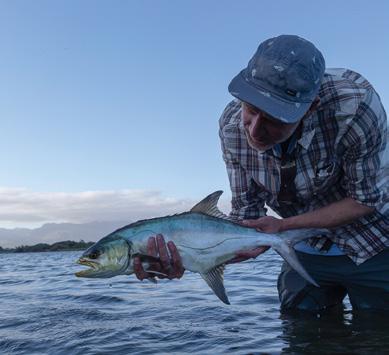
Leonard Flemming (left) and The Mission’s art director Brendan Body (above) with fly-caught South African leervis.
WE ALL WIN
So, other than allowing me to deal with my OCD and assign nipples to this specific platypus, what are the upsides to sorting out this taxonomic challenge? Well if we (fisheries scientists like Warren, Alex and Ed, plus helpful anglers) get it right, it could result in some serious conservation wins for all leeries.
Alex says, “Very little is known about the biology of both the tropical and Med populations. If they are, in fact, different species it will have great implication in terms of their conservation. For example, IUCN (International Union for Conservation of Nature) assessments would consider individual populations and not the entire global population, so solving this would be a good start. If L. amia in South Africa is identified as a new species it would lead to better conservation recognition.“ Potts says, “Once it is all corrected, I suspect that the tropical leerfish will be called Lichia amia (as that is the one that was originally described) and the warm temperate ones will be divided into three different species, probably all belonging to the genus Lichia.” If this happens as Potts predicts, we’d like to open suggestions from the floor for the new Latin name of the South African leerfish. Thus far we’ve got: ‘Lichia maballz’ ‘Lichia snitchiagetstitchia’ ‘Lichia missionus’ (What you don’t ask, you don’t get. Right?)
PROTECTING YOUR FLY FISHING FOR THE FUTURE
